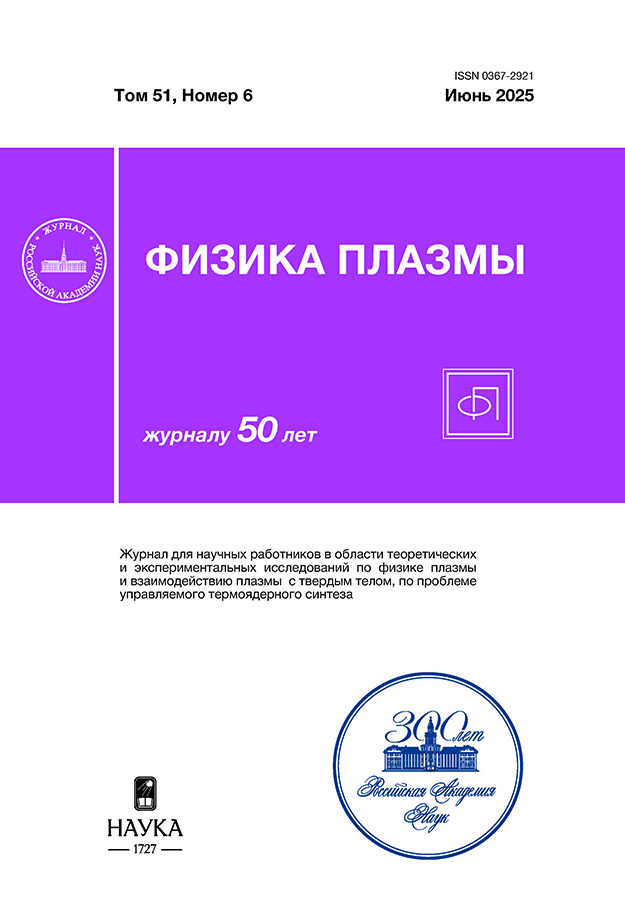Full-wave modeling of electron cyclotron plasma heating at the fundamental and second harmonics for the GDMT facility
- Authors: Gospodchikov E.D.1, Chuvakin P.A.1, Solomakhin A.L.1,2, Shalashov A.G.1
-
Affiliations:
- A.V. Gaponov-Grekhov Institute of Applied Physic of the Russian Academy of Sciences
- G.I. Budker Institute of Nuclear Physics, Siberian Branch of the Russian Academy of Sciences
- Issue: Vol 50, No 12 (2024)
- Pages: 1474-1489
- Section: МАГНИТНЫЕ ЛОВУШКИ
- URL: https://rjsocmed.com/0367-2921/article/view/683750
- DOI: https://doi.org/10.31857/S0367292124120064
- EDN: https://elibrary.ru/EEWBFM
- ID: 683750
Cite item
Abstract
Possible scenarios of auxiliary electron cyclotron plasma heating in various configurations of the next-generation open magnetic trap GDMT (Gas-Dynamic Multiple-mirror Trap) designed at the Budker Institute of Nuclear Physics are considered. For this purpose, a full-wave impedance approach is used to model the interaction of electromagnetic waves with hot plasma, which allows taking into account the interaction of electromagnetic and quasi-electrostatic modes in the vicinity of the electron cyclotron resonance in an axisymmetric magnetic configuration. Heating scenarios using the ordinary electromagnetic mode at the fundamental harmonic and extraordinary mode at the second harmonic are considered. For each case, the ranges of the setup parameters in which such a heating scheme can be effective are determined; optimal for the heating efficiency focusing parameters of the quasi-optical microwave beam are analyzed.
Full Text
About the authors
E. D. Gospodchikov
A.V. Gaponov-Grekhov Institute of Applied Physic of the Russian Academy of Sciences
Author for correspondence.
Email: egos@ipfran.ru
Russian Federation, Nizhny Novgorod
P. A. Chuvakin
A.V. Gaponov-Grekhov Institute of Applied Physic of the Russian Academy of Sciences
Email: egos@ipfran.ru
Russian Federation, Nizhny Novgorod
A. L. Solomakhin
A.V. Gaponov-Grekhov Institute of Applied Physic of the Russian Academy of Sciences; G.I. Budker Institute of Nuclear Physics, Siberian Branch of the Russian Academy of Sciences
Email: egos@ipfran.ru
Russian Federation, Nizhny Novgorod; Novosibirsk
A. G. Shalashov
A.V. Gaponov-Grekhov Institute of Applied Physic of the Russian Academy of Sciences
Email: egos@ipfran.ru
Russian Federation, Nizhny Novgorod
References
- Сковородин Д.И., Черноштанов И.С., Амиров В.Х., Астрелин В.Т., Багрянский П.А., Беклемишев А.Д., Бурдаков А.В., Горбовский А.И., Котельников И.А., Магомедов Э.М., Полосаткин С.В., Поступаев В.В., Приходько В.В., Савкин В.Я., Солдаткина Е.И., Соломахин А.Л., Сорокин А.В., Судников А.В., Христо М.С., Шиянков С.В., Яковлев Д.В., Щербаков В.И. // Физика плазмы. 2023. Т. 49(9). С. 831.
- Bagryansky P.A., Shalashov A. G., Gospodchikov E.D., Lizunov A.A., Maximov V.V., Prikhodko V.V., Soldatkina E.I., Solomakhin A.L., Yakovlev D.V. // Phys. Rev. Lett. 2015. V. 114. P. 205001.
- Yakovlev D.V., Shalashov A.G., Gospodchikov E.D., Maximov V.V., Prikhodko V.V., Savkin V.Ya., Soldatkina E.I., Solomakhin A.L., Bagryansky P.A. // Nucl. Fusion. 2018. V. 58. P. 094001.
- Bagryansky P.A., Anikeev A.V., Denisov G.G., Gospodchikov E.D., Ivanov A.A., Lizunov A.A., Kovalenko Yu.V., Malygin V.I., Maximov V.V., Korobeinikova O.A., Murakhtin S.V., Pinzhenin E.I., Prikhodko V.V., Savkin V.Ya., Shalashov A.G., Smolyakova O.B., Soldatkina E.I., Solomakhin A.L., Yakovlev D.V., Zaytsev K.V. // Nucl. Fusion. 2015. V.55. P. 053009.
- Bagryansky P.A., Demin S.P., Gospodchikov E.D., Kovalenko Yu.V., Malygin V.I., Murakhtin S.V., Savkin V.Ya., Shalashov A.G., Smolyakova O.B., Solomakhin A.L., Thumm M., Yakovlev D.V. // Fusion Sci. Technol. 2015. V. 68. P. 87.
- Хусаинов Т.А., Балакин А.А., Господчиков Е.Д., Соломахин А.Л., Шалашов А.Г. // Физика плазмы. 2024. Т. 50.
- Alikaev V.V., Litvak A.G., Suvorov E.V., Fraiman A.A. // High Frequency Plasma Heating / Ed. A.G. Litvak. New York: AIP, 1991. Ch. 1. P. 1.
- Шалашов А.Г., Господчиков Е.Д. // УФН. 2011. Т. 151. С. 151.
- Shalashov A.G., Gospodchikov E.D. // Plasma Phys. Control. Fusion. 2010. V. 52. P. 025007.
- Господчиков Е.Д., Чувакин П.А., Шалашов А.Г. // Физика плазмы. 2023. Т. 49. С. 953.
- Днестровский Ю.Н., Костомаров Д.П., Скрыдлов Н.В. // ЖТФ. 1963. Т. 33. С. 922.
- Шафранов В.Д. // Вопросы теории плазмы. Вып. 3 / Под ред. М.А. Леонтовича. М.: Госатомиздат, 1963. С. 129.
- Bornatici M., Engelmann F., Maroli C., Petrillo V. // Plasma Phys. 1981. V. 23. P. 89.
- Lazzaro E., Ramponi G., Giruzzi G. // Phys. Fluids. 1982. V. 25. P. 1220.
- Shalashov A.G., Balakin A.A., Gospodchikov E.D., Khusainov T.A. // Phys. Plasmas. 2016. V. 23. P. 112504.
- Шалашов А.Г., Балакин А.А., Хусаинов Т.А., Господчиков Е.Д., Соломахин А.Л. // ЖЭТФ. 2017. Т. 151. C. 379.
- Shalashov A.G., Gospodchikov E.D., Khusainov T.A., Solomakhin A.L., Yakovlev D.V., Bagryansky P.A. // Nuclear Fusion. 2022. V. 62. P. 124001.
- Шалашов А.Г., Господчиков Е.Д., Хусаинов Т.А. // Физика плазмы. 2022. Т. 48. С. 993.
Supplementary files




















